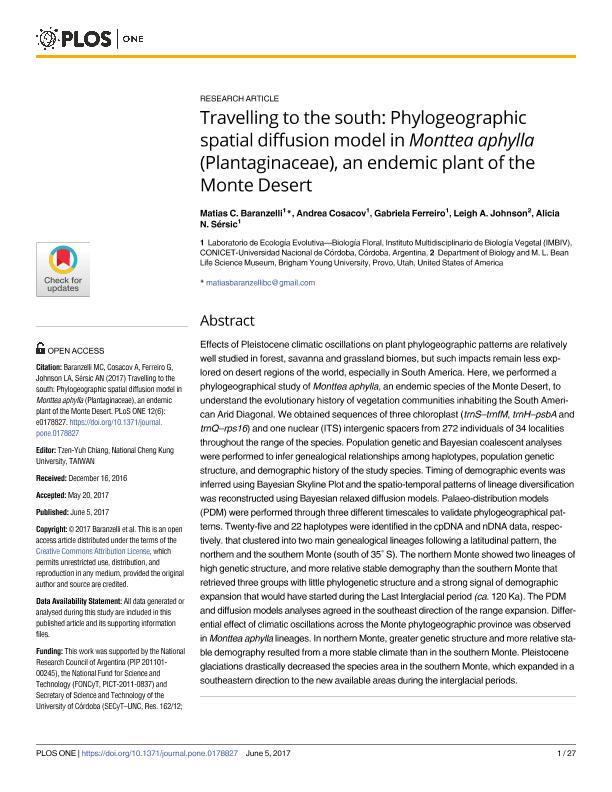Mostrar el registro sencillo del ítem
dc.contributor.author
Baranzelli, Matias Cristian

dc.contributor.author
Cosacov Martinez, Andrea

dc.contributor.author
Ferreiro, Gabriela

dc.contributor.author
Johnson, Leigh A.
dc.contributor.author
Sersic, Alicia Noemi

dc.date.available
2017-09-14T20:50:47Z
dc.date.issued
2017-06
dc.identifier.citation
Baranzelli, Matias Cristian; Cosacov Martinez, Andrea; Ferreiro, Gabriela; Johnson, Leigh A.; Sersic, Alicia Noemi; Travelling to the south: Phylogeographic spatial diffusion model in Monttea aphylla (Plantaginaceae), an endemic plant of the Monte Desert; Public Library of Science; Plos One; 12; 6; 6-2017; 1-27; e0178827
dc.identifier.issn
1932-6203
dc.identifier.uri
http://hdl.handle.net/11336/24311
dc.description.abstract
Effects of Pleistocene climatic oscillations on plant phylogeographic patterns are relatively well studied in forest, savanna and grassland biomes, but such impacts remain less explored on desert regions of the world, especially in South America. Here, we performed a phylogeographical study of Monttea aphylla, an endemic species of the Monte Desert, to understand the evolutionary history of vegetation communities inhabiting the South American Arid Diagonal. We obtained sequences of three chloroplast (trnS–trnfM, trnH–psbA and trnQ–rps16) and one nuclear (ITS) intergenic spacers from 272 individuals of 34 localities throughout the range of the species. Population genetic and Bayesian coalescent analyses were performed to infer genealogical relationships among haplotypes, population genetic structure, and demographic history of the study species. Timing of demographic events was inferred using Bayesian Skyline Plot and the spatio-temporal patterns of lineage diversification was reconstructed using Bayesian relaxed diffusion models. Palaeo-distribution models (PDM) were performed through three different timescales to validate phylogeographical patterns. Twenty-five and 22 haplotypes were identified in the cpDNA and nDNA data, respectively. that clustered into two main genealogical lineages following a latitudinal pattern, the northern and the southern Monte (south of 35˚ S). The northern Monte showed two lineages of high genetic structure, and more relative stable demography than the southern Monte that retrieved three groups with little phylogenetic structure and a strong signal of demographic expansion that would have started during the Last Interglacial period (ca. 120 Ka). The PDM and diffusion models analyses agreed in the southeast direction of the range expansion. Differential effect of climatic oscillations across the Monte phytogeographic province was observed in Monttea aphylla lineages. In northern Monte, greater genetic structure and more relative stable demography resulted from a more stable climate than in the southern Monte. Pleistocene glaciations drastically decreased the species area in the southern Monte, which expanded in a southeastern direction to the new available areas during the interglacial periods.
dc.format
application/pdf
dc.language.iso
eng
dc.publisher
Public Library of Science

dc.rights
info:eu-repo/semantics/openAccess
dc.rights.uri
https://creativecommons.org/licenses/by-nc-sa/2.5/ar/
dc.subject
Cold/Dry Glacial Cycles
dc.subject
Paleo-Distribution Modelling
dc.subject
Plant Phylogeography
dc.subject
Quaternary
dc.subject
Range Dynamics
dc.subject
Relaxed Random Walk
dc.subject.classification
Bioquímica y Biología Molecular

dc.subject.classification
Ciencias Biológicas

dc.subject.classification
CIENCIAS NATURALES Y EXACTAS

dc.title
Travelling to the south: Phylogeographic spatial diffusion model in Monttea aphylla (Plantaginaceae), an endemic plant of the Monte Desert
dc.type
info:eu-repo/semantics/article
dc.type
info:ar-repo/semantics/artículo
dc.type
info:eu-repo/semantics/publishedVersion
dc.date.updated
2017-09-06T19:41:00Z
dc.journal.volume
12
dc.journal.number
6
dc.journal.pagination
1-27; e0178827
dc.journal.pais
Estados Unidos

dc.journal.ciudad
San Francisco
dc.description.fil
Fil: Baranzelli, Matias Cristian. Consejo Nacional de Investigaciones Científicas y Técnicas. Centro Científico Tecnológico Conicet - Córdoba. Instituto Multidisciplinario de Biología Vegetal. Universidad Nacional de Córdoba. Facultad de Ciencias Exactas Físicas y Naturales. Instituto Multidisciplinario de Biología Vegetal; Argentina
dc.description.fil
Fil: Cosacov Martinez, Andrea. Consejo Nacional de Investigaciones Científicas y Técnicas. Centro Científico Tecnológico Conicet - Córdoba. Instituto Multidisciplinario de Biología Vegetal. Universidad Nacional de Córdoba. Facultad de Ciencias Exactas Físicas y Naturales. Instituto Multidisciplinario de Biología Vegetal; Argentina
dc.description.fil
Fil: Ferreiro, Gabriela. Consejo Nacional de Investigaciones Científicas y Técnicas. Centro Científico Tecnológico Conicet - Córdoba. Instituto Multidisciplinario de Biología Vegetal. Universidad Nacional de Córdoba. Facultad de Ciencias Exactas Físicas y Naturales. Instituto Multidisciplinario de Biología Vegetal; Argentina
dc.description.fil
Fil: Johnson, Leigh A.. University Brigham Young; Estados Unidos
dc.description.fil
Fil: Sersic, Alicia Noemi. Consejo Nacional de Investigaciones Científicas y Técnicas. Centro Científico Tecnológico Conicet - Córdoba. Instituto Multidisciplinario de Biología Vegetal. Universidad Nacional de Córdoba. Facultad de Ciencias Exactas Físicas y Naturales. Instituto Multidisciplinario de Biología Vegetal; Argentina
dc.journal.title
Plos One

dc.relation.alternativeid
info:eu-repo/semantics/altIdentifier/doi/http://dx.doi.org/10.1371/journal.pone.0178827
dc.relation.alternativeid
info:eu-repo/semantics/altIdentifier/url/http://journals.plos.org/plosone/article?id=10.1371/journal.pone.0178827
dc.relation.alternativeid
info:eu-repo/semantics/altIdentifier/url/https://www.ncbi.nlm.nih.gov/pmc/articles/PMC5459442/
Archivos asociados
